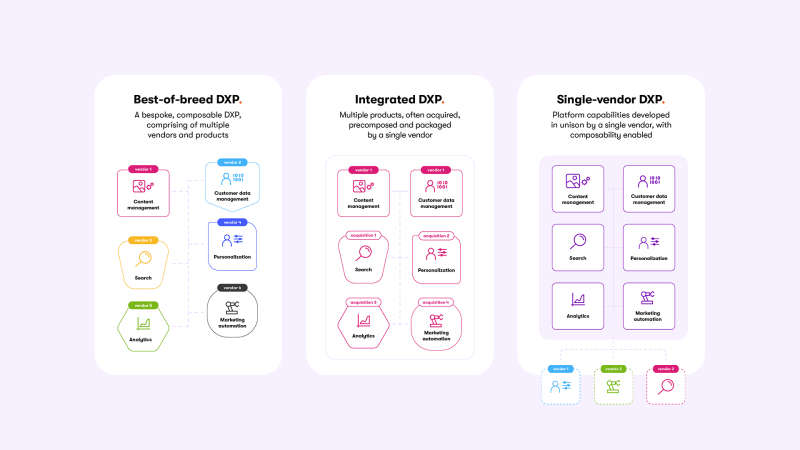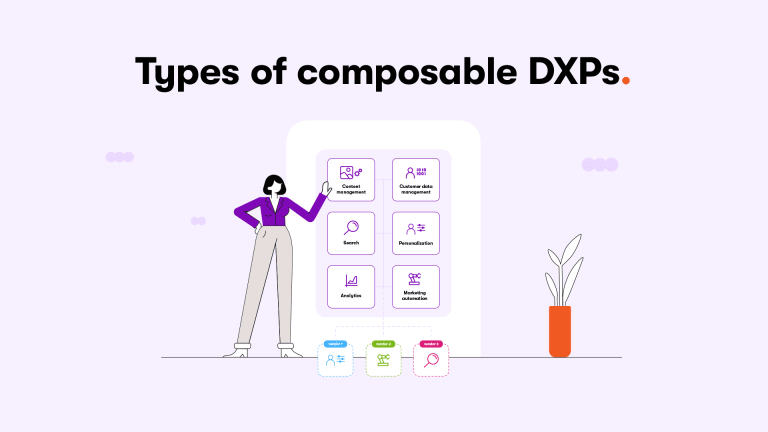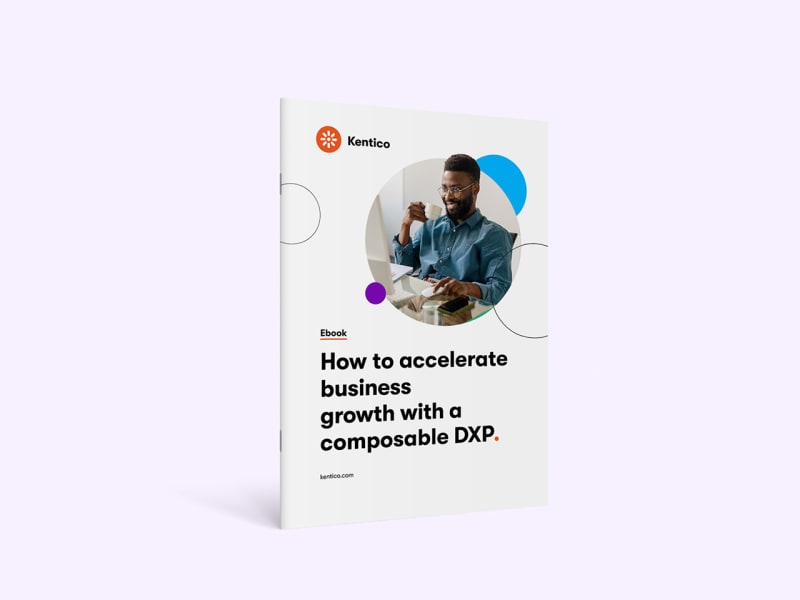Composable digital experience platforms (DXPs) are the future, according to current demand and trend analysis. They can offer such flexibility that monolithic systems can’t compete. On the other hand, the complexity and cost of a composable DXP can cause many CMOs headaches.
Luckily, the offer is broad, and it’s possible to avoid disappointment. This article explains our view on DXP composability and where we see the differences. We also want to help you decide whether a composable DXP is the best solution for your ROI.
What is a composable DXP?
A composable digital experience platform (DXP) is a set of technology components composed together to provide capabilities for managing content and executing digital marketing campaigns. The DXP can have capabilities such as content management, personalization, analytics and optimization, customer journey mapping, customer data management, search, multiexperience support, and many others.
Unlike monolithic DXPs, which offer a pre-packaged suite of non-interchangeable capabilities, a composable DXP takes a modular and flexible approach. As a result, you can select best-of-breed technologies, services, and tools. The core idea behind a composable DXP is to provide a foundation that can adapt and scale as business needs evolve.
Unfortunately, the definition of DXP composability is unclear even in the expert community. Not all technologies that call themselves “composable” give their clients the freedom they promise. On the contrary, the flexibility might be paid for by an excessively complex system with high demands on budget, development team, and time.
3 approaches to DXP composability – pros and cons
Many analysts, industry experts, and solution providers seem to recognize only two types of DXP architecture – composable or monolithic. Fortunately, the market offer is much more varied, and there are several levels of composability for different business needs.
As Una Verhoeven says in her Forbes article: “Something I’ve found while talking to customers is that most of them don’t want to get into the weeds concerning the technical aspects of these frameworks. Rather, they’re more concerned with the capabilities and the end goals: lead generation and customer experience. They’re very happy to learn that there is a hybrid approach that allows “everyone to play well together.”

Best-of-breed composable DXP
This approach expects designing and building a bespoke solution from the ground up, using a combination of capabilities such as CMS, email marketing, commerce, and DAM provided by multiple vendors. The components are interconnected via API and can be swapped for different parts or added on top without changing the whole system.
To build this highly composable platform, you need the expertise of a solution architect. The implementation typically requires a skilled and digitally mature development team. The result is a custom solution consisting of best-of-breed technologies that excel in specific areas.
Who is it for?
Bespoke composable DXPs are designed for large, multinational enterprises with specific needs that require premium products and their high-profile brands demand only the best options on the market without considering the costs.
In the language of our digital experience maturity model, we can imagine such a company as a digital megacity having its dedicated internal team of developers.
Pros:
- Customization: Flexibility to adopt new technologies and features
- Best-of-breed tools: Freedom to select the best tools and services
- Scalability: Vendors are responsible for scaling their services, not customers
Cons:
- Complexity: Teams of solution architects and developers needed for implementation, maintenance, and upgrades, the complexity of the integration grows with more components
- Learning curve: Digital marketing teams need to understand the relationships between the products in the system, knowing when and how to use each one
- Cost: Multiple contracts with different vendors
Pre-composed integrated DXP
In this case, the components of a composable DXP are pre-selected by the vendor and already connected. However, the components were gained by mergers and acquisitions of other vendors. Thanks to that, you don’t need a solution architect to build a bespoke DXP, and it limits the number of contracts and costs. Also, you don’t need to choose the capabilities because the DXP vendor has done the job already.
The question is how they chose the components. This approach is often adopted by fast-growing DXP vendors that gain more product capabilities through business acquisitions. That way, they can quickly create full-fledged DXP with CMS, digital marketing features, and sometimes commerce.
For the DXP vendor, this approach quickly brings a lot of value. But a customer doesn’t have the benefit of choosing the best-of-breed technologies that make up the solution and faces inconsistent user interfaces and workflows caused by acquisitions that weren’t developed together.
Who is it for?
Pre-composed DXPs are a good choice for large corporations that need a wide range of high-quality digital marketing capabilities and don’t worry so much about costs. They are often offered by well-established companies with solid brand awareness, which provides a strong argument for a CIO who needs the investment to be approved by the executive board.
Pros:
- Vendor’s brand awareness: Eases inter-departmental consensus about the DXP purchase
- Extensive set of features: Each component developed with a full range of functionalities
Cons:
- Slow time to market: Capabilities need to be connected, different UX, steep learning curve
- Cost: The inconsistent system results in high implementation, maintenance and upgrade costs
- Difficult upgrades: Marketing teams are subject to the vendors strategic direction with acquisitions and technology selection
Single-vendor composable DXP
In this case, a DXP is developed from the ground up by a single company but with extensibility in mind. The platforms usually provide content management as a centerpiece together with various digital marketing capabilities working in unison. These capabilities all have the same user interface (UI) and underlying software foundations to ensure the best user experience for the admins.
This approach takes the best from both worlds – composable and monolithic. It’s a DXP with native capabilities for content management and digital marketing but ready for the capabilities to be replaced or extended if needed.
The built-in capabilities are all developed by the same team, following the same standards and best practices. They are designed to work together.
Thanks to that, they have a short time to market, a smooth learning curve, and quick value delivery. When you need to replace some of the capabilities with the best-of-breed, a composable DXP by a single vendor can be used for headless content delivery, extended, and connected with ready-to-use or custom integrations.
Who is it for?
A composable DXP by a single vendor suits fast-growing mid-sized to lower-enterprise companies embracing digital transformation and mindful of their ROI. This type of DXP can be quickly implemented as a single solution for content management and most digital marketing scenarios.
Right from the start or when your needs change, the DXP can be extended and integrated with the technologies of choice without migrating the whole system. This way, the costs are kept under control, and the system doesn't become unmanageable.
Pros:
- Value for money: A single contract with one vendor, one product for all essential needs
- Fast time to market: All ready-to-use capabilities follow the same UX and software foundations
- Extensibility: Unlike monolithic DXPs, composable DXP by a single vendor enables composing new capabilities
Cons:
- Not always best-of-breed: Although perfectly sufficient for most companies, the native DXP capabilities are not necessarily best-of-breed
Watch a video to learn more:

Three types of composable DXP
Watch this video to learn about three types of composable DXPs and decide which is the best for your ROI.
Is Kentico a composable DXP?
On the composability landscape sketched above, Kentico represents the composable DXP by a single vendor that starts as a single product. That means composability is an option but not a necessity. Xperience by Kentico is designed to go live as quickly as possible and helps companies grow without needing large, painful upgrades and migration in the future.
Apart from the built-in capabilities for content management and digital marketing that you know from monolithic DXPs (content and contact management, personalization, email marketing, etc.), Xperience by Kentico has many powerful capabilities common in the composable world.
These include headless to support content delivery via multiple channels (web, email, mobile apps, landing pages, social media, …), software-as-a-service (SaaS option), modular structure, and structured content, all immediately available out of the box. But, instead of pre-composing these capabilities into packaged solutions that don’t completely fit any customer, Xperience by Kentico enables customers and their implementation partners to create a custom solution tailored to their specific needs.
And if you wonder how to leverage composable solutions for your business growth, read our free ebook: How to accelerate business growth with a composable DXP.


